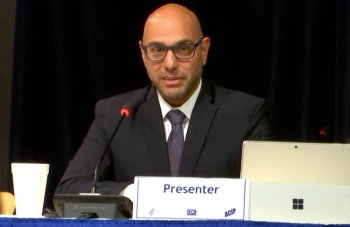
How physicians should watch their money carefully when moving on
When considering a practice merger or an opportunity to join a new group, keep a close eye on retirement accounts
Merging with another group practice or leaving a practice for a new opportunity consumes a huge share of mind as physicians work through the details, and retirement accounts are often neglected in the process.
That oversight can sink the very nest egg physicians are trying to build with their career move.
It isn’t just physicians, of course. Nearly one in five U.S. adults reported leaving $50,000 or more behind at workplace retirement plans, a 2010 ING Direct survey found.
But with many physicians now considering mergers or new employment arrangements, it’s important to find the best place to house those old accounts.
Amid substantial churn as doctors join hospital networks or merge, retirement accounts are often being neglected, says David Martin, vice president, tax exempt client analytics & research at Fidelity Investments, which recently published a study on physicians and their retirement savings habits.
Although physicians overall are saving an average of nearly 20% percent of their salaries per year, too many are falling well short of the recommended minimum of 15%, according to a Fidelity study of more than 13,000 physician retirement accounts. The bottom 48%, in fact, manage to sock away just 9% annually, the study found. And 45% are not saving the maximum amount allowed in workplace plans.
Despite very high salaries – physicians studied earned an average $300,000 a year – most physicians also carry high debt levels from medical school, the study noted. And of course, many physicians earn considerably less than $300,000.
In addition, 61% of the physicians surveyed reported confusion about some aspects of retirement saving, but just 21% took advantage of workplace financial guidance programs available through their practices.
Frequent errors
Common mistakes physicians make in retirement planing include failing to close out a 401(k) plan properly before a merger and not scrutinizing the plan to be used in the future to make sure they are putting away enough for retirement, experts say. And physicians who are moving to new employment may simply leave retirement money behind in a sub-optimal plan.
On the plus side, practice transitions can be a great opportunity to increase retirement savings if done right.
Interventional cardiologist Joel Erickson, MD, of Santa Rosa, California, recently created a defined benefit pension plan for his solo practice vein clinic and is discussing a new 401(k) plan with his partners in a separate group practice that is in the process of aligning with a hospital foundation.
The moves will allow Erickson, 60, to make six-figure contributions to his retirement plan, making up for some lean years during and after the 2008 recession. And by purchasing the vein clinic in 2012, he says, he has diversified his income as he heads into the last years of his career.
Buying the clinic not only provided a vehicle for retirement savings, it created more job security by diversifying his practice income and lessened his call demands, he says.
The purchase of the vein clinic followed a few difficult years when his group practice had not been able to make 401(k) contributions, which provided extra incentive for branching into new service lines, he says. And as part of aligning with a hospital, the group practice will be starting a new retirement plan, creating more opportunities for retirement catch-up strategies, he says.
Starting a new corporate entity also enables the practice to consider a variety of additional benefits, and the physicians are considering several options on everything from retirement plan vendors to employee health insurers.
Avoiding merger pitfalls
Along with the opportunities, there are plenty of pitfalls to be aware of when moving old 401(k) or 403(b) plans, experts say. “Generally, you don’t want to merge a bad plan with a good one,” because if something wasn’t handled properly in one plan, it can disqualify the entire new entity, says Roberta Casper Watson, JD, a partner with Wagner Law Group’s Tampa, Florida, office.
Particularly as practices seek complex affiliations and arrangements with hospitals as opposed to outright mergers, she says, it can be tricky to make sure all plans are in compliance with federal laws governing workplace retirement plans.
Sometimes, Watson says, a plan might not qualify to be shut down and have its assets distributed to employees if the employees are continuing virtually every aspect of their previous jobs following the transition. There are also ways of structuring transitions so as to tailor different plans to different groups of employees. “In one deal the doctors wanted to keep their retirement plan so we spun off the rank and file employees and merged them into the [acquiring] hospital’s plan,” she says.
Timing is crucial in these deals, she adds, because if retirement plans aren’t terminated before a merger closes, participants lose the option of cashing out their accounts or rolling them into an IRA.
Of course, financial advisers usually loathe the idea of cashing out a retirement plan. But having more flexibility, particularly to switch assets to an IRA, is widely seen as a key benefit, she says. “We typically prepare a board resolution on the day before the merger date, then we can do the wind-up tasks such as IRS approval and certain notifications after that. If this isn’t done ahead of the deal, the buyer is stuck with a possibly tainted plan” that could run afoul of federal rules, Watson says. “I find that each transaction is different, particularly when it involves doctors. They seem to have their own angles” or tweaks on how merger or affiliation details will go.
Meanwhile, says Fidelity’s Martin, doctors in group practices need to assess whether keeping an old retirement plan in a merged practice is worthwhile, or if it’s better to roll it into a new practice plan. And if the new plan allows participants to roll in other retirement plans he says, it can be desirable in two ways compared with rolling funds into an IRA: IRAs can be vulnerable to creditor claims in certain situations, and fees tend to be lower in institutionally priced workplace plans than the retail fees charged in IRAs, he says.
But the integration process can be challenging, particularly when large numbers of practices come together in a short time, with each practice essentially keeping its original retirement plans intact. Experts say the plans basically become orphan systems that are bound together but don’t have robust oversight.
“In maybe half of these mergers you have an acquiring plan sponsor keep the existing benefit structure,” Martin says, recalling a large health system that ended up with more than a dozen benefit plans as it acquired practice after practice.
“From a strategy perspective, plan sponsors are trying to stay away from that because you end up with a big disparity in employee outcomes. A nurse in one system looks totally ready for retirement, while another in a similar job is not. And yet terminating these plans and keeping people whole (according to benefits originally promised) can be difficult,” he says.
In cases where there are disparities, he adds, practices may need to consider other types of incentives, such as salary increases, to sell employees on the need for single retirement plan.
A patchwork of plans is undesirable from a governance standpoint as well, notes Donald Trone, GFS, founder and chief executive of 3ethos, a Mystic, Connecticut-based consulting firm specializing in corporate leadership and fiduciary issues. Oversight suffers because of plan complexity, he says.
But evaluating a new plan isn’t easy, Trone concedes. He recommends starting by asking a potential merger partner for a copy of the practice’s retirement plan, including its investment policy statement. Hopefully, this will clarify whether the potential partner views the 401(k) plan as an important leadership role in the organization or a nuisance.
“Another litmus test is the number of investment options in the [merger partner’s] plan,” he says. “More usually doesn’t mean more prudent. Doctors all have their favorite asset class or fund family and they put pressure on the investment committee to add it to the plan, but the more options there are, it makes oversight and monitoring more difficult and expensive.”
Investment committees also should evaluate the performance of each investment option on a quarterly basis, he says. Due to time constraints, many do not.
Solo moves
On an individual level, too, the demands of keeping track of multiple retirement plans at previous practices can be significant, says Jim MacKay, CFP, a financial planner in Springfield, Missouri. “By the time clients find me they often have old accounts with a couple of previous employers and just left them sitting there because doing nothing was the easiest route,” he says. Especially for doctors, who often work in non-profit organizations with 403(b) plans instead of 401(k)s, the standard advice about workplace plans having lower expenses may not apply, he says.
“In my experience the 403(b) world is worse than the 401(k) world in terms of expenses, investment choices and flawed adviser relationships,” he says. “In almost all cases I encourage people to roll those plans into an IRA.”
Of course, doctors should evaluate their own current investment costs and see how they stack up against either a new workplace plan or a typical IRA portfolio, he says. In addition, he encourages clients contemplating joining or merging with a group to read the summary plan description of the group’s retirement plan. Unlike generic marketing material, this is a guiding document that lays out all the fees the plan charges to savers.
“Research suggests the most important metric in evaluating these plans is cost,” he says. “I’m cheap, so when I look at the investment lineup, if the bulk of the options charge more than a half percentage point, I’m looking to see why. We really want funds that are down in the teens,” he said, referring to fund expense ratios below .20 of 1% per year of invested assets.
A final reality check is that depending on the practice situation, the days of being able to put large savings into workplace plans may be ending, Watson says. That’s because when doctors join larger practices with many employees, rules governing highly compensated workers sometimes limit contributions.
“Doctors who have been contributing maximum levels of funds into retirement accounts will probably have to tone that down if they merge into a larger organization,” she says.
On the other hand, some doctors still struggle to save at all. Pediatrician Terence McAllister, MD, of Performance Pediatrics in Plymouth, Massachusetts, reinvests most profits back into the practice, even though he knows his IRA is underweight. “I’ve managed to save some money in an IRA, but most of the cash has gone into my business,” he says.
It’s a tradeoff he’s willing to make. “I’ve decided to focus now on keeping the practice as independent as possible,” he says. “To save more I would have to abandon the practice and go to work for somebody.
Newsletter
Stay informed and empowered with Medical Economics enewsletter, delivering expert insights, financial strategies, practice management tips and technology trends — tailored for today’s physicians.















